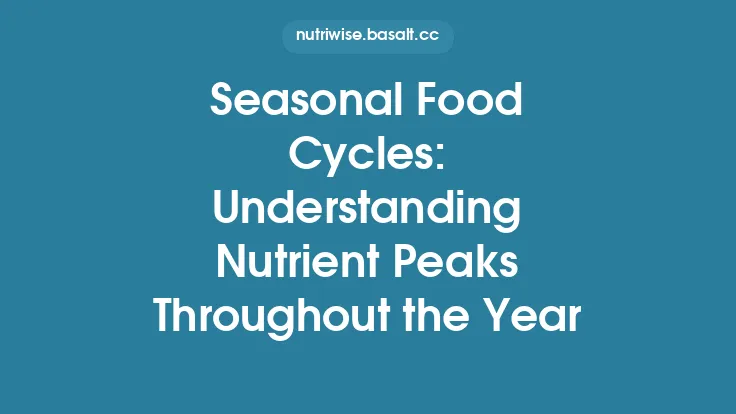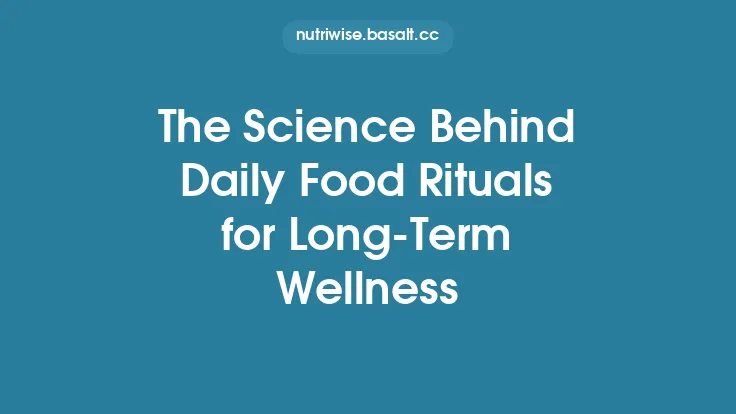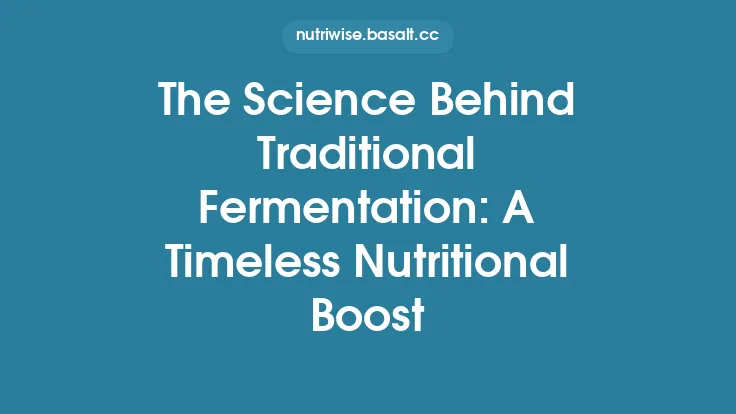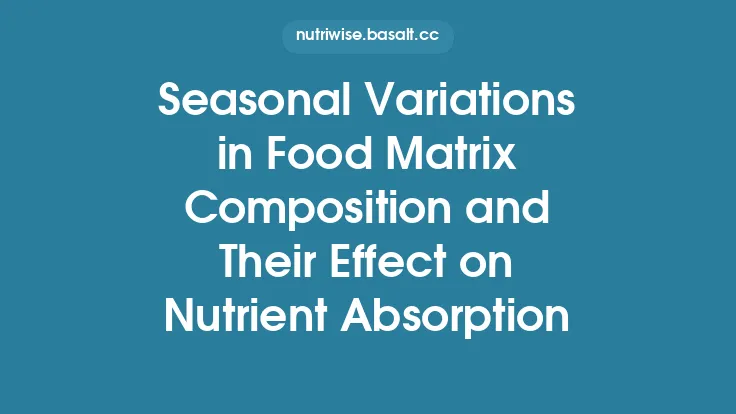Seasonal variations in the natural world are far more than a visual spectacle; they are a finely tuned biochemical orchestra that determines when fruits, vegetables, grains, and legumes reach their nutritional zenith. Understanding why certain produce bursts with vitamins, minerals, and phytochemicals at specific times of the year requires a deep dive into plant physiology, environmental science, soil ecology, genetics, and post‑harvest biology. This article unpacks the scientific mechanisms that drive nutrient peaks in seasonal foods, offering a comprehensive view that remains relevant regardless of culinary trends or market fluctuations.
Plant Physiology and Nutrient Accumulation
Plants synthesize and store nutrients in response to developmental cues and metabolic demands. Two primary physiological phases dictate nutrient profiles:
- Growth Phase (Vegetative Stage)
- Photosynthetic Activity: During early spring, increasing daylight and moderate temperatures boost photosynthetic rates, leading to higher carbohydrate production. Excess sugars are stored as starches in roots and tubers (e.g., carrots, potatoes).
- Nitrogen Assimilation: Young leaves prioritize protein synthesis for rapid cell division. This results in elevated levels of amino acids, chlorophyll, and associated micronutrients such as iron and magnesium.
- Reproductive Phase (Flowering & Fruit Set)
- Carbon Allocation: As plants transition to flowering, carbon is redirected from vegetative growth to reproductive structures. This shift often triggers the accumulation of soluble sugars and organic acids in fruits, enhancing sweetness and flavor.
- Secondary Metabolite Production: The need to attract pollinators and deter herbivores stimulates the synthesis of flavonoids, anthocyanins, carotenoids, and glucosinolates. These compounds are responsible for the vivid colors of berries, tomatoes, and cruciferous vegetables and are among the most potent antioxidants in the human diet.
The timing of these phases is tightly linked to photoperiod (day length) and temperature thresholds, which act as environmental signals that synchronize internal hormonal pathways (e.g., auxins, gibberellins, and ethylene). Consequently, the same species harvested at different points in its life cycle can exhibit markedly different nutrient compositions.
Environmental Influences on Phytochemical Synthesis
Beyond internal plant cues, external conditions shape the biosynthesis of vitamins and phytochemicals:
- Light Quality and Intensity
Ultraviolet‑B (UV‑B) radiation stimulates the production of flavonoids and phenolic acids as protective agents against DNA damage. For instance, kale grown under higher UV exposure contains up to 30 % more quercetin than shade‑grown counterparts.
- Temperature Fluctuations
Cold stress activates the expression of genes involved in the synthesis of vitamin C (ascorbic acid) and certain carotenoids. Winter‑grown Brussels sprouts, for example, often have higher glucosinolate concentrations than those harvested in milder conditions.
- Water Availability
Drought triggers osmotic stress responses, leading to increased accumulation of soluble sugars and osmoprotectants like proline. These compounds not only aid plant survival but also enhance the nutritional value of the edible parts.
- Atmospheric CO₂ Levels
Elevated CO₂ can boost overall biomass but may dilute certain micronutrients (e.g., iron, zinc) due to a “growth dilution” effect. However, the impact varies among species and is moderated by nutrient availability in the soil.
Collectively, these abiotic factors create a dynamic environment where the same cultivar can exhibit a spectrum of nutrient densities across different seasons and microclimates.
Soil Health, Microbiome, and Mineral Uptake
The soil ecosystem is the foundational source of mineral nutrients, and its health directly influences the nutrient peaks of seasonal produce.
- Soil pH and Cation Exchange Capacity (CEC)
Optimal pH ranges (typically 6.0–7.0 for most vegetables) maximize the solubility of essential minerals such as phosphorus, potassium, calcium, and magnesium. Deviations can lock nutrients in unavailable forms, reducing their uptake.
- Organic Matter and Mycorrhizal Associations
High levels of organic matter improve soil structure, water retention, and nutrient buffering. Mycorrhizal fungi form symbiotic relationships with plant roots, extending the effective root surface area and facilitating the acquisition of phosphorus, zinc, and copper—micronutrients that often peak in seasonal crops.
- Nitrogen Cycling
The balance between nitrifying and denitrifying bacteria determines the form of nitrogen (ammonium vs. nitrate) available to plants. Leguminous crops, such as peas and beans, fix atmospheric nitrogen through Rhizobium symbiosis, leading to higher protein content during their peak harvest periods.
- Soil Microbiome‑Mediated Phytochemical Induction
Certain soil microbes produce signaling molecules (e.g., siderophores, phytohormones) that can upregulate plant secondary metabolism. Studies have shown that tomatoes grown in soils enriched with beneficial Bacillus spp. exhibit increased lycopene concentrations.
Thus, nutrient peaks are not solely a product of above‑ground conditions; they are deeply rooted—literally—in the health and diversity of the soil ecosystem.
Genetic Regulation and Seasonal Gene Expression
Even within a single species, genetic variation determines how strongly a plant responds to seasonal cues.
- Quantitative Trait Loci (QTL) for Nutrient Content
Researchers have mapped QTLs linked to vitamin C, anthocyanin, and mineral accumulation in crops like strawberries and carrots. Breeding programs that select for favorable alleles can amplify seasonal nutrient peaks without sacrificing yield.
- Epigenetic Modifications
DNA methylation and histone acetylation patterns shift in response to temperature and photoperiod, altering gene expression without changing the underlying DNA sequence. These epigenetic changes can be transient (seasonal) or heritable, influencing nutrient profiles across generations.
- Circadian Clock Genes
The plant circadian clock synchronizes metabolic pathways with day–night cycles. Genes such as *TOC1 and LHY* regulate the timing of flavonoid biosynthesis, ensuring that antioxidant production aligns with peak sunlight exposure.
Understanding these genetic mechanisms enables scientists to predict which cultivars will exhibit the most pronounced nutrient peaks under specific seasonal conditions, guiding both breeding and agronomic decisions.
Post‑Harvest Dynamics and Nutrient Retention
Harvesting marks the beginning of a new set of biochemical processes that can either preserve or degrade the nutrients accumulated during the growing season.
- Respiration Rate
After harvest, produce continues to respire, consuming stored sugars and oxygen. High respiration rates (common in leafy greens) accelerate the loss of vitamin C and other labile nutrients. Cooling the produce immediately slows respiration, helping retain peak nutrient levels.
- Enzymatic Oxidation
Polyphenol oxidase (PPO) catalyzes the browning of cut fruits and vegetables, simultaneously degrading phenolic compounds. Antioxidant treatments (e.g., ascorbic acid dips) can inhibit PPO activity, preserving phytochemical content.
- Cell Wall Integrity
Mechanical damage during handling disrupts cell membranes, releasing enzymes that degrade nutrients. Gentle harvesting techniques and minimal processing are crucial for maintaining the integrity of nutrient peaks.
- Storage Atmosphere
Modified atmosphere packaging (MAP) that reduces oxygen and increases carbon dioxide can extend shelf life while preserving vitamin C and carotenoids. However, overly restrictive atmospheres may induce anaerobic respiration, leading to off‑flavors and nutrient loss.
The window between peak nutrient accumulation in the field and consumption is therefore a critical period where post‑harvest handling practices can either lock in or erode the nutritional advantages of seasonal produce.
Analytical Methods for Assessing Nutrient Peaks
Accurate quantification of nutrient levels is essential for validating seasonal peaks and informing both growers and consumers.
- High‑Performance Liquid Chromatography (HPLC)
Widely used for separating and quantifying vitamins (e.g., B‑complex, C) and phytochemicals such as anthocyanins and flavonols. Coupled with photodiode array detectors, HPLC provides precise concentration data across harvest dates.
- Mass Spectrometry (MS) and LC‑MS/MS
Offers high sensitivity for detecting trace minerals and metabolites. LC‑MS/MS is particularly valuable for profiling complex polyphenol mixtures in berries and grapes.
- Inductively Coupled Plasma Optical Emission Spectroscopy (ICP‑OES)
Enables rapid multi‑element analysis of macro‑ and micronutrients (e.g., calcium, iron, zinc) in soil and plant tissue, facilitating correlation studies between soil health and nutrient peaks.
- Near‑Infrared Spectroscopy (NIRS)
A non‑destructive, rapid technique for estimating moisture, sugar content, and some vitamins in intact produce. While less precise than HPLC, NIRS is useful for large‑scale monitoring of seasonal trends.
- Metabolomics Platforms
Untargeted metabolomics, using techniques like gas chromatography‑MS (GC‑MS), can capture the full spectrum of metabolites that fluctuate seasonally, revealing novel nutrient markers and pathways.
Standardizing sampling protocols (e.g., time of day, maturity stage) and employing these analytical tools ensures that reported nutrient peaks reflect true biological variation rather than methodological artifacts.
Implications for Consumer Health and Dietary Recommendations
The scientific insights into seasonal nutrient peaks translate into tangible health benefits:
- Optimized Antioxidant Intake
Consuming fruits and vegetables at their phytochemical peak maximizes intake of antioxidants such as lycopene, beta‑carotene, and flavonoids, which are linked to reduced oxidative stress and lower risk of chronic diseases.
- Enhanced Micronutrient Bioavailability
Seasonal peaks often coincide with higher levels of mineral chelators (e.g., organic acids) that improve the absorption of iron and zinc. For example, the increased citric acid in early‑summer tomatoes can boost iron uptake.
- Synergistic Nutrient Interactions
Seasonal produce tends to contain balanced ratios of vitamins and phytochemicals that work synergistically (e.g., vitamin C enhancing the absorption of plant‑based iron). Aligning meals with these natural synergies can improve overall nutrient utilization.
- Reduced Need for Supplementation
When diets incorporate seasonally peak‑rich foods, the reliance on fortified foods or dietary supplements may decrease, supporting a more whole‑food‑based nutrition strategy.
Public health guidelines can incorporate these findings by emphasizing “eat with the seasons” as a strategy for achieving nutrient density, rather than focusing solely on generic daily servings.
Future Research Directions and Sustainable Practices
While the current body of knowledge elucidates many mechanisms behind seasonal nutrient peaks, several avenues merit further exploration:
- Climate Change Impact Modeling
Predictive models that integrate temperature, precipitation, and CO₂ scenarios can forecast shifts in nutrient peaks, guiding adaptive breeding and agronomic practices.
- Microbiome Engineering
Manipulating soil and rhizosphere microbial communities to enhance specific nutrient pathways (e.g., mycorrhizal strains that increase zinc uptake) offers a sustainable route to boost seasonal nutrient content.
- Phenotyping Platforms
High‑throughput phenotyping using drones and hyperspectral imaging can map nutrient hotspots across fields in real time, enabling precision harvesting at peak nutrient moments.
- Consumer‑Facing Nutrient Transparency
Development of rapid, low‑cost sensors (e.g., handheld NIR devices) could empower shoppers to verify nutrient peaks at the point of purchase, fostering informed seasonal choices.
- Integrative Breeding Programs
Combining traditional breeding with CRISPR‑based gene editing to fine‑tune seasonal expression of key biosynthetic genes could produce cultivars that consistently deliver peak nutrients across broader geographic ranges.
By aligning scientific research with sustainable agricultural practices, the food system can better harness the natural rhythm of seasonal nutrient peaks, delivering healthier produce while preserving ecological integrity.
In sum, the science behind seasonal food nutrient peaks is a tapestry woven from plant developmental biology, environmental physics, soil ecology, genetics, and post‑harvest biochemistry. Recognizing and leveraging these mechanisms enables growers to optimize crop quality, equips consumers to make nutritionally superior choices, and informs policymakers seeking to promote sustainable, health‑focused food systems. The seasonal dance of nutrients is not a fleeting curiosity—it is a fundamental, evergreen principle that underpins the nutritional power of the foods we eat.





